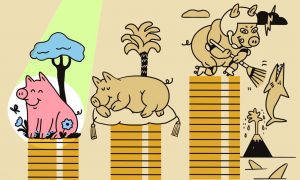Along with a run on Clorox wipes and a national obsession with Anthony Fauci, the coronavirus outbreak has triggered an identity crisis for high-yield savings accounts. Interest rates have fallen precipitously, and that has savers exploring other ways to maximize their money.
There are money market accounts, which are “like savings accounts that pay interest, offered by banks and insured by the FDIC,” says Angela Holliday, president of Frost Brokerage Services in Texas. And then there are money market funds, which are “investments in short-term government-issued securities offered by investment firms.”
Let’s discuss the first one first. Lots of banks and credit unions include money market accounts in their offerings alongside the standard checking and savings accounts. Money market accounts are similar to savings accounts but typically have a higher yield; sometimes they also have checks or debit cards. They also have restrictions on how many times in a month you can access my money via transfers and withdrawals.
You may have noticed the word “typically” in the previous paragraph — that’s because everything is upside-down these days thanks to the coronavirus. Interest rates are largely influenced by the Fed, and that applies here, too. The gap between a regular savings account and a money market account isn’t that significant right now.
This time last year, the national average rate for money market accounts containing $100,000 or less was 0.18% — double the 0.09% average for savings accounts.
Right now, though, the average for money market accounts is 0.08%… unimpressive compared to the 0.06% average for savings accounts.
Still, money market accounts might be a good option to consider when you’re looking at your overall situation, says Sean Wilson, a senior director of investment products at financial services organization TIAA.
“Because of what’s going on, lot of people have had to rely more on their savings,” he adds. “Making sure they are maximizing where they can — that’s important. Understanding the difference is important.”
Moving on to money market funds. Also called money market mutual funds, these are investment products. By nature, they’re not insured by the FDIC, meaning my money isn’t protected. In theory, you could lose it.
Money market funds are usually for short-term investing, working “similar to cash accounts where the number of dollars you invest is the number of shares you own,” Holliday says. They can help people get “more return on their money versus an interest-bearing bank account,” but there is a degree of risk involved because of that lack of FDIC backing.
“Money market funds may be part or all of an investment portfolio, and determining if that’s good for the investor is only based on the individual investors’ investment objectives and financial condition,” Holliday adds.
Even so, Wilson says they’re still conservative as far as investments go — and a solid option if you’re moving around assets. It’s quick and easy to access, so you can park money there while you figure out what you really want to do with it.
Bottom line? It’s a personal decision as to whether you need a money market account (which is basically a savings account) or a money market fund (which is an investment). In choosing which is best for you, you should be aware of the current financial climate, look at the yields, weigh the risk involved and consider how you can access them.
It’s all about your goals. What do you want your money to do? For example, if you’re looking for a place to keep your emergency fund, Wilson says both money market accounts and funds could work. They’re not going to beat inflation in the long run, but they can generate small returns while still staying relatively liquid.
The post Money Market Accounts vs. Funds: What’s the Difference, and Which Is the Best Place to Put Cash Now? appeared first on Money and is written by Julia Glum
Original source: Money






